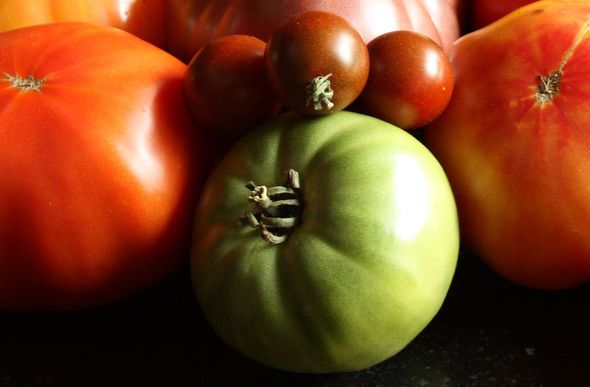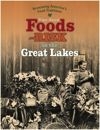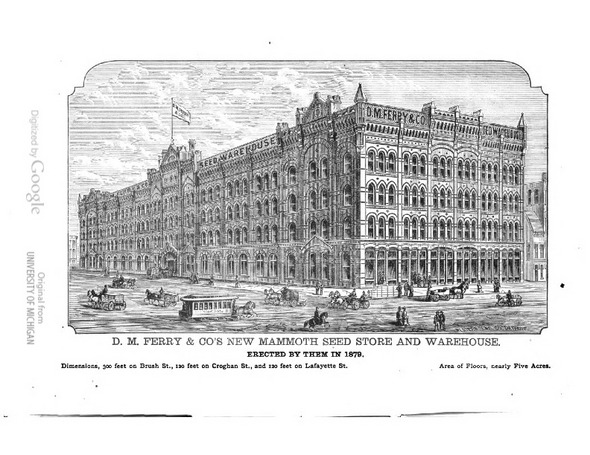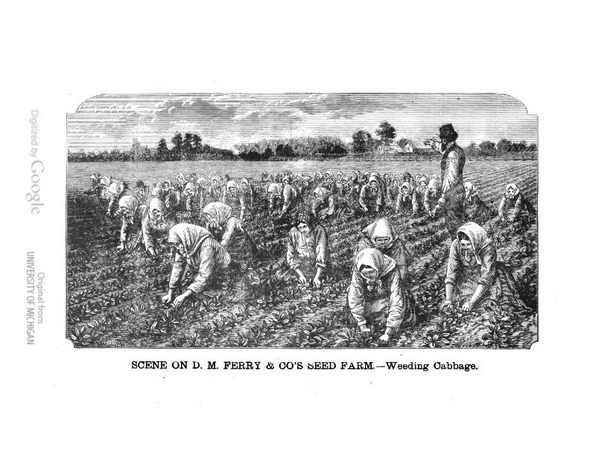Local groups will offer heirloom seeds adapted to Great Lakes region

Contributor | Kim Bayer
Aunt Ruby's German Green Tomato
The main thing I'm interested in is heirloom tomatoes. Even with our great CSA farm share, I just can't get enough. I devote the majority of my tiny growing space to a handful of tomato plants that produce a rainbow of colors and flavors. Aunt Ruby's German Green is my hands-down favorite. The fruits are bright green, and when perfectly ripe they soften with a golden tinge. The flavor is sweet, tart and spicy all at once, and the texture is silky smooth. It's so delicious it was recently inducted into the Slow Food Ark of Taste. And the plants are prolific — last year I had tomatoes from them until a hard frost in late October. I ate the last one that ripened off the vine in December.
The Seed Saver's Exchange Yearbook first listed this tomato in 1993, when it came, via Bill Minkey and Nita Hofstrom, from Ruby Arnold of Greeneville, Tenn. Ruby Arnold originally got it from her German immigrant grandfather and called it just "German Green." Minkey asked Arnold's permission to change the name to "Aunt Ruby's German Green." So before she died in 1997, she knew that there was a tomato with her name on it. Along with making me want to grow this tomato, this story illustrates several of the qualifications used to define an "heirloom."
The main qualification that Seed Savers uses to define an heirloom is that it was handed down between generations, like any other precious family antique. Second, it's something that has been grown since before 1950, when much of the craze for hybridization began. Third, wIth its thin skin and explosive flavor, I know Aunt Ruby's German Green was bred for taste over travel — another qualification that makes it unlike its leather-skinned supermarket cousins. And finally, since I've grown it from saved seed, I know that it's open pollinated — successive generations grow true to the original type, which is not the case with hybrids.
What's also interesting about Aunt Ruby's German Green tomato is that it came from, and was adapted to, a particular place. Tennessee. Sometimes people complain that heirlooms are finicky or that hybrids give more standard results. But I wonder whether that would be the case if we still knew or had Michigan heirlooms that were adapted to our particular microclimates and that had developed their own genetic resistance to our main pests.
The latest figures I've seen say that the top 10 seed companies own two-thirds of the world's seeds. Monsanto, the world's leading producer of the herbicide Roundup and 90 percent of genetically engineered seed, alone owns one-quarter of the world's seeds. According to Slow Food USA, "93% of American food product diversity has been lost since 1900," and "only thirty plants feed 95% of the world's population." Many of the farmers I've talked to recently who grow row crops (wheat, soy, corn) say they can no longer find a local supplier of non-GMO seeds. For people who care about a future filled with more than shelf stable items, these are reasons to learn about and protect the heirloom foods of the Great Lakes region.

From Slow Food USA
It turns out there are a few different ways to find out about old Michigan varieties. The one that got me started thinking about this was a list put together by author and professor Gary Nabhan for Slow Food USA. "Foods Potentially at Risk in Michigan" is part of the Slow Food RAFT project for "Renewing America's Food Traditions." This list of "place-based heritage foods (that) were historically produced and eaten in our foodshed," includes threatened, endangered, and extinct wild and native Great Lakes foods (like American Lotus and Oswego Tea), domesticated livestock (like the Beltsville White Turkey, Java Chicken and Kerry Cattle), and long lists of old orchard fruits (like the PawPaw apple and Monstrous of Douay peach). And also heirloom foods from the garden. Some that I still recognize — like Henderson's Bush Lima and Early Rose potatoes. It's a list of that was published with a request for help in documenting the survival status of each.

From the DM Ferry 1881 Seed Annual
What's been even more fascinating has been learning that our area was once a literal hotbed for seed production. In 1856 Dexter Ferry started the D.M. Ferry and Co. seed business (which became Ferry-Morse) in what's now the very center of downtown Detroit. In its heyday, it employed more than 700 people. The 1881 Ferry Seed Annual advertises their "new mammoth seed store and warehouse," erected in 1879 as fronting 300' of Brush Street, and 120' and Lafayette streets. Their test garden, notes the catalog, "is easily accessible, being located on Woodward Avenue, with horse cars passing every five minutes….Here are collected and grown under similar conditions, samples of all the different varieties, the different stocks of each variety and the scores of new sorts which are annually sent out. A careful record of their development is kept and the slightest difference in their value accurately noted…we think an examination of the perfect specimens of all the most improved varieties of vegetables and the new sorts not yet given to the general public, would amply repay any one interested in gardening for a visit to these grounds."

From the DM Ferry 1881 Seed Annual
Not far away and a draw for visitors from around the world, they were especially proud of the land they amassed at Grand River and Joy Road to grow out the seeds listed in their catalog. "For this purpose a small farm was purchased many years ago, just outside the city limits, and by means of systematic and complete tile-draining, liberal manuring and thorough tillage it was soon brought to the highest degree of fertility. To this we have added field after field and farm after farm until today our seed farms extend one and one-quarter miles on Grand River Avenue in one direction, and about a mile on the Joy Road in another. Our farms are probably the best cultivated tract of equal extent in Michigan; indeed, a prominent English agriculturist, who had traveled much both in Europe and America, remarked after visiting them that he had never seen in any country so large an area under so perfect a state of cultivation."
Going through the old D.M. Ferry seed annuals is instructive. They grew a lot of things back then that we don't any more. Artichokes, both Globe and Jerusalem. Eight varieties of celery. Chicory as a substitute for coffee: "In the fall, the roots require to be taken up and cut in small pieces, and put in a sandpit where they will dry, requiring the same treatment used in drying apples." Chufa "Earth Almonds" for fattening hogs. Corn salad, a hardy winter green. The 1885 catalog lists 32 different varieties of cabbage noting, "There is no vegetable more universally cultivated than this. It is found in the poorest, smallest yard, and it responds so readily to better care that it is also entitled to a place in the finest gardens, and merits the attention of the most skillful gardener." By comparison, there are only 21 varieties of tomatoes in the catalog, and none have names that I recognize. I'm continuing to go through those old catalogs to see if there are some names that I will recognize as being still available today.
Not that there aren't heirloom tomatoes available at our many summertime farmers' markets. Wilson's, a certified organic farm in Tipton, Mich., brings nearly 60 heirloom tomato varieties to the Ann Arbor Farmers' Market every week in season. And for people who want to grow their own heirlooms, Project Grow Gardens is unparalleled in the number of starts they sell at their spring plant sales.
This year for the first time, Slow Food Huron Valley is teaming up with Project Grow (and a few other wonderful organizations and individuals) on a "Michigan Heirloom Seed Trial." Erica Kempter, Slow Food Board Member and owner of Nature and Nurture, has put together a database of garden favorites traditionally grown in our region. Slow Food Huron Valley will be purchasing about 30 different varieties and providing the seeds for Project Grow to start this spring. If all goes well, gardeners will be able to buy and plant these tasty heirlooms that have been adapted to our region. We're asking gardeners and a few trial farms to participate in giving feedback about how these Great Lakes heirlooms grow and how they taste. We're hoping to use some of these vegetables to a create a special "Heirlooms of Michigan" tasting at the HomeGrown Festival on Sept. 10 this year.
We may not have a seed company in our area any more, since Ferry-Morse moved to Western Kentucky in 1959. But we do have Royer Held and Marcella Trautmann, local gardening heroes who have been instrumental as educators, seed savers and proponents of heirloom varieties for Project Grow. While you're waiting for their classes and the plant sales to start, check out some garden porn from Seed Saver's Exchange, Sand Hill Preservation Center and Baker Creek Heirloom Seeds as starting points for some old time pleasures.
Kim Bayer is a freelance writer and culinary researcher.


Comments
Wystan Stevens
Sun, Feb 13, 2011 : 7:44 p.m.
Let us not forget that Ann Arbor has a direct connection to the D. M. Ferry seed company. It was U-M alumnus Dexter Ferry's 1902 gift of twenty acres of land on State Street as an addition to the University's existing recreational grounds that became the present Ferry Field athletic campus. And, since I cannot resist the pun, I will say that it was there that seeds were planted that grew to become the Maize and Blue's peerless athletic heritage. The University's Bentley Historical Library has a pageful of interesting info about Mr. Ferry and Ferry Field: <a href="http://bentley.umich.edu/athdept/stadium/stadtext/ferry.htm" rel='nofollow'>http://bentley.umich.edu/athdept/stadium/stadtext/ferry.htm</a>
Kim Bayer
Sun, Feb 13, 2011 : 4:40 p.m.
Thank you AlphaAlpha, Vivienne and KJMClark for the kind words. Alpha - I'd love to know more about how to find seeds of Jeffersonian descent. Vivienne - it's true that many (most?) of our agricultural policies were created at an earlier time and very much need to be updated to address the issues of today. But as you note, the vested interests in power will make change unlikely unless citizens are informed and engage in the process. Both locally and nationally. KJMClark - I believe the Ferry company actually had more than one building near Brush and Lafayette. I have a suspicion that the building that currently houses Fishbones may have been one of them. I'm trying to find out! Elaine - Thanks for asking about endangered animal breeds. Kerry is the cattle breed that I mention in the article. The Beltsville White is a turkey. The American Livestock Breed Conservancy, a group dedicated to "ensuring the future of agriculture through genetic conservation and the promotion of endangered breeds of livestock and poultry" lists the status of both of these breeds as "critical." Where "critical" means that fewer than 200 are registered annually, and the global population is estimated to be under 2000 individuals. Belted Galloway cattle are listed as "recovering," which they explain as having been once listed as either "critical," "threatened," or "watch," and which now has a global population of 10,000 or more, but still needs monitoring. The American Livestock Breed Conservancy is a great resource for learning more about the history, development and traditional uses of heirloom animals: <a href="http://albc-usa.org/" rel='nofollow'>http://albc-usa.org/</a>
Elaine F. Owsley
Sun, Feb 13, 2011 : 1:12 p.m.
There are Belted Galloway cows on a farm on Territorial. Is that the variety you say is extinct?
KJMClark
Sat, Feb 12, 2011 : 2:27 p.m.
Wow. Who would have thought there was once a seed company in Michigan. That would be a nice business to get back. And as you wrote, it's hard to find 50# bags of organic seed. The best sources I've found are Albert Lea Seed in Minnesota and Johnny's in Maine. But the shipping cost on less than a pallet of seed is painful. I have to drive up to the thumb to get most of our seed, where there's a local co-op that gets a truck load. Peripherally related, if you look at the location where the Ferry Seed building used to be, it's now most likely a parking lot. Three out of the four corners are parking. That says a good bit about the problems in Michigan. We get rid of business space and replace it with car parking, because we prioritize car travel over any other travel. People decided that since we're the "motor capital", we had no use for transit. We were going to show the rest of the country the way it should be - big expressways and block after block of car parking. Pick an equivalent part of downtown Chicago and you find less than half the car parking, but a dense network of bus lines and rail lines, with bigger commuter rail lines close by. If you don't have transit, you have to have the car parking. If you have to have the car parking, you have to kick out some businesses. So when do we give up on our current model and try one that works? It would be nice to make room for a local seed business again. Just think of all the room we'd have for buildings if we converted 1/3 the surface parking in the state.
Chase Ingersoll
Sat, Feb 12, 2011 : 4:12 p.m.
KJM Clark - to ship a 500 lb pallet of seeds from Maine to Ann Arbor is only $200.00....maybe less if you can get me to go in on it with you.
Vivienne Armentrout
Sat, Feb 12, 2011 : 2:21 p.m.
Thank you for this excellent article. It is indeed disturbing that Monsanto owns so much of the world's seed production, including vegetable seed. It is also disturbing that industrial agriculture is driving many of the decisions that will limit the quality of our food and the choices of what can be grown. Some of this tension is seen even in our own locality, with the different needs and desires of commodity row crop growers vs. growers for local consumption. The New York Times recently had an alarming article about approval of genetically engineered corn that is good for corn ethanol production but not for food. <a href="http://www.nytimes.com/2011/02/12/business/12corn.html?_r=1&scp=1&sq=genetically%20engineered%20corn&st=cse" rel='nofollow'>http://www.nytimes.com/2011/02/12/business/12corn.html?_r=1&scp=1&sq=genetically%20engineered%20corn&st=cse</a> It makes you wonder whether we should place some restrictions on what can be grown on locally subsidized lands. Oh whoops - we are bound by US agriculture policy - which is dominated by corn growers from Iowa.
AlphaAlpha
Sat, Feb 12, 2011 : 2:10 a.m.
Great article. Seeds are vital for human survival. Seeds from descendants of Jefferson's plants may yet be available.